Part II - Thoroughbred and Soundness
This second study on durability and soundness centers on the Thoroughbred. It was launched to investigate not only the bloodlines that seem to promote these much needed qualities in the breed, but to find common root carriers of resiliency between the breeds of Standardbred, American Thoroughbred and Quarter Horse because they were all the same breed until the 1800s. The Thoroughbred has traditionally been looked to as the chief component in sport horse breeding, for its ability to transmit speed, agility, courage, overall athleticism on much less sporty breeds. The modern racing Thoroughbred has soundness problems (as do the warmbloods and other sport breeds) and many riders and breeders are unsure how to pick out a good Thoroughbred for non-racing sport or for their herd improvements.
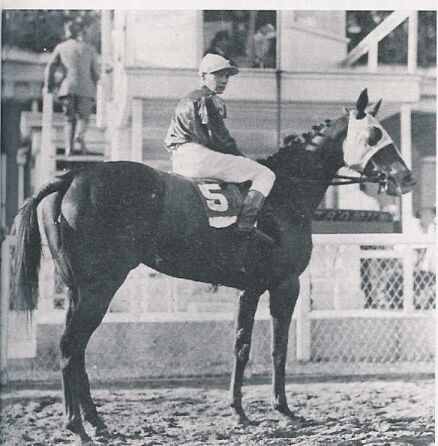
Pan Zareta 1911, she started in 151 races and won 76 in her short 6 year career--she died of pneumonia in her stall at the racetrack. This is a 50% win record, her speed was unmatched, better than the much celebrated Mumtaz Mahal, and her number if starts is hard to beat. This mare, who had no offspring, is one of the greatest races horses of all time.
A horse that can stand up for years of racing or competition and/or run in hundreds of races has something valuable to teach us. The task of isolating the key bloodlines in the Thoroughbred were not as straight forward as in the previous Standardbred study (part 1) which had multiple current horses winning over 100 races and a few bloodlines clearly emphasized (further along I will provide a clue coming from a new science study for why this may be so). For whatever reasons, the Thoroughbred has notably fewer centurions than the Standardbreds, although with the help of Robert Flieger I did locate one horse that can rightfully be added to those who have won over 100 starts. I enlisted the help of the facebook group Bloodlines of the Sport of Kings to find durability specimens in the modern Thoroughbred, and got several examples you will see here from their contributions. So a big thanks to Tony Byles, Robert Flieger, Lou Flieger, Michael Felts, Juianna Ochs, Tamara Ault, and Yvelle Eve Hirsch for your important suggestions.
With steeplechasers, it is often a three or four mile course with fixed jumps, an extreme testing, which of itself shows great soundness and durability...only the toughest horses are successful in it. The horses in this study have birth dates from 1830 to 2004, so we have a much longer range then the previous exercise, which may give us an advantage in finding clues on root bloodlines.
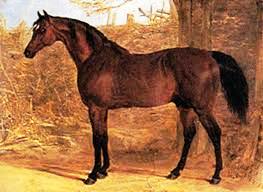
[Whisker 1812, he is the sire of one of the earliest durability stars on the list: Catherina and his line and that of his full siblings: Whalebone, Web, Wire, Woful, Wilful etc. are found as one of the critical mass influences behind a good number of the sound horses in this study. These full siblings are found more often than not in multiples in the English Thoroughbred; Whisker and Whalebone were Derby winners, and their sister Web is the dam of the prolific Glencoe so they are seen more often than the others.]
As we did in the Standardbred section, I will list the horses with name/date of birth (dob) and country, chief dominance, and secondary dominance in parenthesis, followed by closest inbreeding-linebreeding. Some of the entries will be dominant in certain bloodlines because of a strong configuration and closeness to the front of the pedigree, others will be by critical mass.
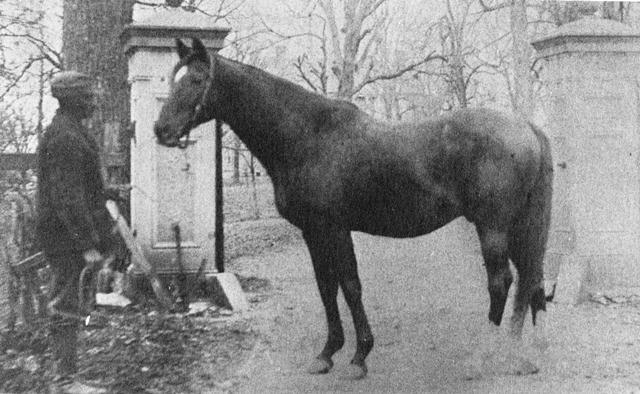
[Spendthrift 1876, a new American Thoroughbred, is the sire of two that made our list: Bankrupt who ran more races than any other; 348, and Kingston who raced 138 races. Spendthrift had three full stallion brothers: Rutherford, Miser and Fellowcraft. Spendthrift is the sire of Hastings, who is the sire of Fair Play, who himself is the main influence in Time To Bid (below), and he is the sire of Man O'War and the grandsire of Discovery...all three are chefs de race for stamina, and also a major jump line in the USA. Fellowcraft is the damsire of the mighty Hamburg, a great stayer. Only two horses have won staying races by 100 lengths: Man O' War and Hamburg--that is a clue. The chef de race Discovery is the damsire of both Bold Ruler and Native Dancer and Discovery has Fellowcraft/Spendthrift 4x5 sex-balanced. Fellowcraft holds the world record for 4-mile heat racing, beating his grandsire Lexington's record by a 1/4 of a second.]
Durable and Sound Thoroughbreds
name/dob race record 1st dominance 2nd dominance closest inbreeding
Catherina 1830 (GB) 176 starts/78 wins Snap (Herod-Highflyer, Sir Peter, Eclipse) 3x3x4
Boston RH 1833 (USA) 112 starts/80 wins Diomed (Wildair Mare, Regulus, Eclipse, Fearnought) 3x3 heat racer, total is actual starts, not race meets.
Bankrupt 1883 (USA) 348 starts/89 wins Whalebone et al (Herod-Highflyer, Eclipse-Melbourne) 4x4
Kingston 1884 (USA) 138 starts/89 wins Whalebone et al (Melbourne, Herod, Eclipse, Glencoe, Touchstone) 4x4
Imp 1894 (USA) 171 starts/62 wins Stockwell/Rataplan (Lexington RH, Orville) 4x4x5
Pan Zareta 1911 (USA) 151 starts/76 wins Bonnie Scotland (Birdcatcher, Glencoe, Lexington RH, Boston RH) 4x4
Exterminator 1915 (USA) 100 starts/50 wins Blair Athol/Blinkhoolie (Stockwell/Rataplan, Vededa/Que Vive, Newminster) 5x5x5
Galgo Jr 1927 (Puerto Rico) 158 starts/136 wins Galopin (Touchstone, Pocahontas, St. Simon-Newminster) 6x6x4x6
Red Rum 1965 (Ireland) steeplechase 110/26 wins flat and jumps St. Simon/Angelica--Fairway/Pharos (equal potency) (Polymelus, Cyllene, Newminster, Tadcaster, Scapa Flow, Bona Vista) 4x4
Time to Bid 1975 (USA) 179 starts/50 wins Fair Play (Sweep--St. Simon, Galopin) 5x5x6, 5x6, 5x6
Sir Prize Birthday 1980 (USA) 206 starts/39 wins Nearco-St.Simon (Mumtaz Begin, Blandford, Galopin) 4x6
Mustard 1997 (Australia) 131 starts/17 wins Princequillo (Nearco-Nasrullah-Native Dancer, Phalaris) 6x6x5, 5x6
Base Stock
As you can see in the above chart, the earliest main dominance is Snap, and this line appears in many others. I will enlarge on the first four entries' main potencies: Snap, Trumpator, Diomed, Sir Archy and see what we come up with for roots. And then see if these identified bases stay dominant in the later stars of resiliency.
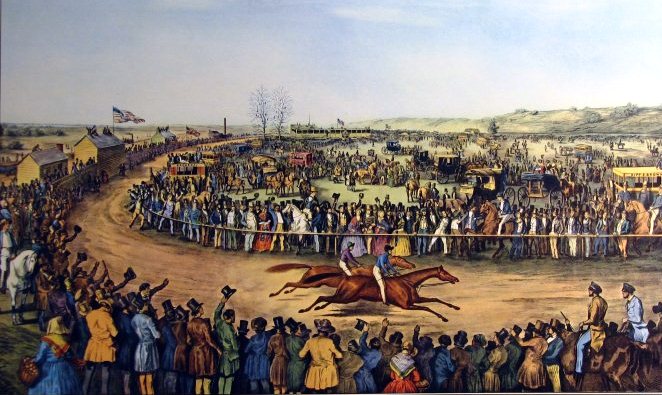
Four Earliest Achievers and their Main Dominance
In these studies, the genetic dominance is identified by pedigree (Tesio Methods) and the pedigree is read as a genetic road map (see Understanding Pedigrees). Because of the vast amount of pedigree analysis required, the 21 entries themselves, then their main dominance's pedigrees, and then the further typesetters in those horses, is so great, I do not spend the time and detail I would normally. I have developed what I call 'speed analysis' whereby I quickly determine the chief potency and ignore the lesser pedigree points. Some of you may want to revisit the horse's lineages and discover those fine points that I have missed or omitted...this is meant as an overview only, to quickly focus on the sources of these traits--if possible.
In our earliest four entries in our study: Catherina 1830 is most dominant in Snap 1750, Jorrocks 1833 is most potent in Trumpator 1782, Boston RH 1833 is most potent in Diomed, and Fashion RH 1837 is most potent in Sir Archy. (Click on each individual link below to bring up the pedigree).
If you take a look at Snap's pedigree you will quickly see that the majority of early lines were Barb (or Turk)-Running Horse/Hobby. This is the true base of the Thoroughbred. Snap is a grandson of Flying Childers, who, with his full brother Bartletts Childers (aka Bleeding Childers), is a back bone of the developing Thoroughbred. Snap's strongest potency however is Leedes Arabian 5x6x4x5, a domestically bred Running Horse/Oriental cross. Also secondary strengths from Byerley Turk 4x5x5 and Spanker (who is found in Leedes Arabian) is 5x5x7x6x7 and Hautboy is 6x4x5 (1/2 to 3/4 Hobby).
Trumpator carries Snap in his 3rd generation but his main dominance is Partner 4x5x4, with secondary buildups of Godolphin Arabian 4x4 and Greyhound Mare 5x4. Partner is by Jigg, a tremendously inbred horse being 2x1 to Spanker Mare; so he was bred back to his own dam, and Partner's ancestors born in 1690 or before had very few imported Orientals to descend from, and so were most likely related to those in Spanker, which makes for a very concentrated gene pool. Partner will appear in strength in several more entries.
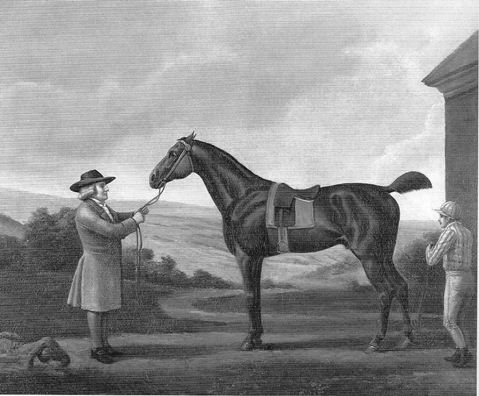
[Diomed 1777, imported in 1798 (at age 21) was a fortunate exception to the other Thoroughbreds being brought in to America in this era. He was not only remarkably sound, he transmitted wonderful traits of stamina, speed and soundness.]
Diomed 1777 was a very good racehorse born as the classic race was made the performance test of the English breed, a winner at 4-mile heat racings, he also won the first Derby. He was exported to America at age 21 and he bred until his death at age 31; an indication of vitality and durability in itself. He is one of the most influential English imports to America's racehorse. His greatest potency is the full brothers Flying Childers/Bartletts Childers who are 5x6x7x7x5x5x4, a very consistent genotype which was made stronger by the 3/4 siblings Blaze and Sister to Steady 4x3 pulling it forward. The full siblings Points/Bald Galloway are 6x6 as well. and his brother are the bedrock of the early Thoroughbred horse. Flying Childers was fast and he is by the Darley Arabian, not an Arabian, now believed to be a Turk, with no parentage of course, and his dam is Betty Leedes who is inbred 2x2 to Spanker sex-balanced out of Cream Cheeks, daughter of Spanker out of Hautboy Mare, who is largely of Hobby blood and will play a strong part in other entries in our list. Points and Bald Galloway have strong Hobby blood as well.
I believe Bartletts Childers, also known as Bleeding Childers because he was a bleeder and therefore did not race, may be the first recorded 'bleeder' in the English racehorse.
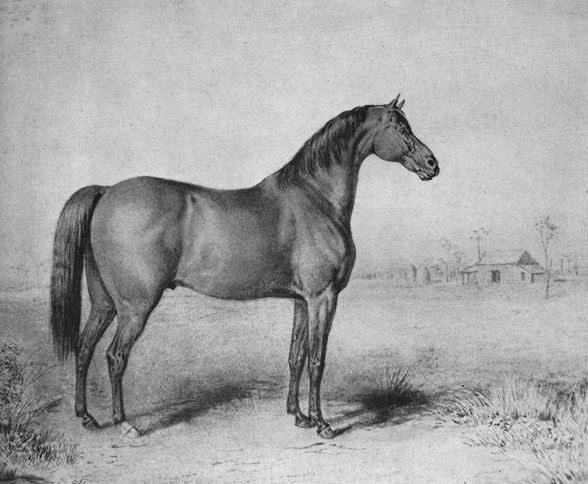
[Sir Archy 1802, a full Thoroughbred bred in America before there was an American Thoroughbred breed. Fantastic heat racer and sire.]
Sir Archy 1802 was a champion 4-mile heat racer and he is 3x3 in Fashion RH, and it is a testament to his first rate genetics that he is also 3x2 in another great heat racing mare: Trifle RH, plus the mega-sire and heat racing champion Lexington RH is 3x4 to Sir Archy. He passed on tremendous amounts of both speed and stamina and soundness; plus we know from the Standardbred Study (part I) that he was the sire of arguably the greatest racehorse of all time: Walk in the Water RH 1813.
Sir Archy is 3x4 Herod, and 5x5x6 Partner with background power of Flying Childers/Bartletts Childers 6x7x6x6x7x7x7, which makes Herod stronger... very similiar potency to that of Diomed above. We talked about Partner above; now let's look at Herod a little closer because he is fast becoming a significant bloodline.
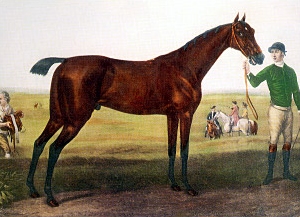
Herod 1758 as we will see further on is a bloodline of significance in the breed as a whole, and a main ancestral source of the jump trait (Standardbred Sport Horses) in the Thoroughbred and the rest of the world's jumpers. He was a 4-mile heat racer and he became a great sire. It is hard to be fully decisive with partial pedigrees, as we will see in many of the early horses; with what is apparent in his lineage we find his strongest dominance is the Spanker Mare, an extremely inbred horse being 2x1 to Old Moroccan Mare (a Oriental-Hobby cross). She is 5x4x6x7x7x7 in Herod, plus there is a line of her sister Cream Cheeks and her brother Careless. Herod then is very much a Spanker Mare typesetter, and seeing his tremendous stature as a foundation of excellence in not just racing but in all sport, the Spanker Mare, despite her inbreeding was one wonderful mare.
Herod is often seen in the lineages through is best son: Highflyer. What does Highflyer's dam Rachel bring that makes him so strong genetically? She brings in Bartletts Childers making the full brothers 4x4, sex-balanced, plus the full siblings Points/Bald Galloway 4x4. Highflyer is a line found in critial mass in most dressage horses as well as jumpers. It is interesting that Janus 1746, an early Thoroughbred import to the States that became a foundation sire, is 4x3 Bald Galloway/Points, making it a fascinating coincidence that he was known not just for producing sprinters but saddle horses of excellence (saddle horses of the day were gaited).
Sir Peter (aka Sir Peter Teazle) is another son of Herod seen consistently. He is 4x4x3x4 Flying Childers/Bartletts Childers with a strong Fox and Regulus presence...both bring in strong Hobby genetics. Other Herod sons seen quite often are Bagot and Woodpecker.
Other consistent dominance show up in the first four and in strength in the others, such as, Eclipse, Whisker/Whalebone et al, Matchem and Regulus.
Bald Galloway 1705 is 5/8 unrecorded Oriental: St. Victors Barb and Fenwick Barb, and 3/8 unrecorded RH-Hobby.
Regulus 1739 is 4x3 Hautboy, 5/8 of his pedigree is unrecorded Oriental: Godolphin Arabian and St. Victors Barb. Strong line in St. Simon.
Matchem 1748 is 4x3 to 3/4 siblings Jigg/Sister to Leedes, and 6x5x5x4 Spanker Mare---similiar dominance in Herod.
Eclipse 1764, an undefeated racehorse (18 starts-18 wins, and if we adjust this record to actual starts it would be 45 starts and 36 wins) in the heat-racing century in England, he is 3x4x4 to full siblings: Sister to Old Country Wench/Smiths Son of Snake, and more genetic power is added to this power configuration by Snake, because there is 5x4x5x5 to the 3/4 siblings Snake/Cream Cheeks. He carries background strength of 31 lines of Yellow Turk. Eclipse is extremely potent.
The classic race standard was established in 1776 with the St. Leger (2 miles run once--dash race). In the next few decades 4-mile heat racing faded and disappeared in Britain. In America, however, heat racing continued on for another 100 years.
Whisker 1812 is the sire of the first two entries on our list, and his full brother Whalebone is the chief dominance in two others. Further, there are several other full siblings: Waxy Mare, Web, Wilful, Woful, Wire, plus their genetic full sister Pawn Junior who is out of the full sister to the other's dam: Pawn. These full siblings are found throughout the Thoroughbred in multiples, they are part of the fabric of the breed, like Flying Childers and his brother are. You will see familiar names in their lineage: their dam is by Trumpator, Snap is found 5x4, Herod is 3x4, Partner is 5x6x7x6x6x6, plus the 3/4 brothers Cade/Regulus are 5x5x5x6.
What can we gather from this data? 1. That the Oriental/Running Horse cross is truly at the base of the Thoroughbred, 2. That Flying Childers et al and Herod and his tribe, seem to be carrying forward the potency best that resulted in the strength found in these horses. Others such as Partner, Bald Galloway, Whalebone et al and Eclipse surely play a important role as well. Looking beyond the first four and their base potencies, we find the same elements stay consistently dominant for 50 years (see chart). But then at approximately Imp 1894, we see newer names appearing: Stockwell, Lexington RH, Orville, Bonnie Scotland, Galopin, Birdcatcher, Slane, Blair Athol, Newminste, Vedada, St. Simon, Touchstone, Cyllene, Dark Ronald, Fair Play, Bull Dog, Black Toney-Blue Larkspur, Teddy, Plucky Liege, Nearco-Nasrullah, Native Dancer, Phalaris and Vimy.
So let's look at the genetic components of some of the new potencies in the 19th century in order of their year of birth.
Birdcatcher 1833, who is a grandson of Whalebone and he is a Herod warehouse (5x6x6x6x7x7x5x5x5x5), along with several lines of Eclipse (5x6x5x5), found in multiples in the later born entries, and he along with his full brother Faugh-a-Ballah are a constant in sport stock of all disciplines. He is the grandsire of Stockwell, great grandsire of Blair Athol, and he is also one of the major jump lines in the world.
Slane 1833 is 3x2 to the 3/4 siblings Lady Mary/Orville, and he has Highflyer 6x5x4x4, and Herod 6x6x7x5x7x6x6x5x5x5.
Bonnie Scotland 1853 is 4x5 Whalebone et al (Herod, Snap, Partner), 5x6x7x6 Gohanna/Precipitate (3x3 Tartar, 5x5 Squirt).
Stockwell 1849 is 4x4x4 Whalebone et al, 4x4 Eleanor/Marmion (2nd dam Giantess, 3x4 Herod and 4x3 Matchem)
Lexington RH 1850 by Boston RH, he was a world champion 4-mile heat racer and even though many of his offspring were ridden off into oblivion in the Civil War, he still today holds the world sire record of 16 years lead sire. His pedigree is an example of extreme critical mass (we will see a similar concentrated design in St. Simon). He has a huge filly factor in 22 lines of Cypron, dam of Herod and Lady Bolingbroke, he also has a background power of 117 lines of Betty Leedes. He is 4x4x5 Diomed, 3x4 Sir Archy, 4x5x5 to the 3/4 siblings Orville/May/Azalia, and 5x6x6x5 to the 3/4 siblings Stamford/Walton/Royalist/Gilliflower, and 6x7x6x6 to the 7/8 brothers Sir Peter (aka Sir Peter Teazle)/ Hydes Highflyer.
Touchstone 1852 is 3x5 Whalebone, 5x6 Prunella/Peppermint, and 4x5x5 Selim/Rubens
Blair Athol 1861 is 4x4 to 3/4 Elana/Marmion (Eclipse, Herod, Diomed), 5x5x5x6x5 Whalebone et al, 6x5 Walton/Williamsons Ditto (3x4 Herod, 3x4 Snap, 5x4x4x5 Regulus), and 6x5 Wanderer/Golumpus (3x3 Herod, Regulus/Sister to Regulus 4x4, Godolpin Arabian 6x5x5)
Spendthrift 1876 is 4x5 Emilius, 6x5x4x5 Whisker/Web etc, and Sir Archy 5x6. he is sire of Bankrupt and Kingston and is head of the stamina Fair Play dynasty. He is by the great Australian and out of Lexington RH mare: Aerolite RH, full sister to Idlewild RH, the greatest 4-mile heat racer during the Civil War.
[In the midst of finishing up this study James Hardiman alerted me that the traditional sireline of St. Simon was not correct, that he descended not from the Darley Arabian, but from the Byerley Turk. St. Simon and his sire Galopin reshaped the English Thoroughbred, and their genetic reach is incredible, to discover they are not who we thought was distressing. Fortunately, Mr. Hardiman had already done some work on this upset and I suggest you read his report. I had to redo St. Simon's pedigree three times before I got it right, which is what you will see on the link below.]
Galopin 1872 , he is an remarkably potent horse and his son St. Simon is even more so. Galopin's main front potency is 3x4x3 to 3/4 siblings Voltaire/Nell who are sons and a daughter of Blacklock. Blacklock's sireline has been corrected as his sire Whitelock is really by Delpini, not Hambletonian. Every quadrant of this pedigree is intertwined with close sibing configurations, like a tightly wired circuit board, making him a stallion of immense ability to set type. And that front potency is focusing forward like a laser for the tremendous background critical mass in Partner.
St. Simon 1887 he is 3x5 to 3/4 Merope/Velocipede (5x3 Whiskey (Eclipse, Herod), 5x4 Sir Peter--5x4 Y.Giantess, 4x4 Voltaire, and 7x6x6x6 Orville/Orvillina (Herod). St. Simon's pedigree is much more then these mentioned dominance. Like his sire, almost every entry from the 5th generation until the 7th is involved in one or more close siblings connections. The corrected error which was Blacklock's sire Whitelock being a son of Delpini, not Hambletonian, might have been a minor adjustment if it was a single instance but Blacklock lines dominate the pedigree 5x6x5x6 and are made even stronger when pulled forward by the 3/4 siblings Merope/Velocipede 3x5. The entire lineage is all wired together making strong conhesive potency, and in the far background there is a huge concentration of 230 lines of Partner and 199 of Regulus. Also of interest in that St. Simon carries at least 30 draft crosses.
Cyllene 1895 is 6x5x6x6 Birdcatcher/Faugh-a-Ballah (Herod), 7x7x7x7x7 Whalebone et al, 4x5 Newminster, 4x4 Stockwell, and 6x6 Melbourne (4x5 Trumpator, 4x4 Sir Peter)
Dark Ronald 1905 is 5x5x6 Stockwell/Rataplan, 6x5 Landercost/Ostinia, and 7x8x7x7x7 Whalebone et al
We can see overall the above power lines have concentrated the original elements that made the breed successful. What happened when the 20th century arrived?
Fairway 1925/Pharos is 4x3 St. Simon (Partner), 4x5 Springfield, Galopin 5x4x7x6, 14 lines Rataplan/Stockwell, Newminster (Herod) power behind
Fair Play 1905 is 4x6 West Australian, 6x6x6 Emma/Maria + 3/4 Hercules, 4x7x5 Newminster, 7x5x6x7 Birdcatcher
Sweep--Black Toney--Blue Larkspur all Lexington RH concentrates via Domino lines who is 3x4x4 to Lexington RH
Bull Dog 1927/Sir Gallahad is 4x3 Concertina/Orme made stronger by Angelica/St. Simon, plus Ormonde is 3/4 brother to Doremi 5x3, 4x4 Tadcaster/The Mersey (Newminster), plus 3/4 Knowsley/Wellingtonia 5x5, lots of Stockwell/Rataplan 7x6x6x6x7
Nearco 1935 St. Simon/Angelica 5x4x4x7x5, plus a powerful Carbine-Polymelus nick by 7/8 The Mersey/Tadcaster 6x5, and 7/8 Musket/Quivewr 5x5, and 3/4 sisters Y. Melbourne Mare/West Australian Mare powering them.
Princequillo 1940 Galopin dominance (12 lines) pulled forward by St. Simon/Angelica 5x6x5 and by 3/4 siblings St. Marguerite/Dinah/Friars Balsam 6x6x6
Zeddaan 1965 4x4 Pharos/Fairway--made stronger by 3/4 siblings Maid of the Mist/Lemberg/Polymelus 6x6x6x5x5x5, also 6 lines of Cyllene, 32 lines of Galopin in the background.
The largest aggregates of durability blood then appear to be Herod (Spanker Mare) and Partner (Spanker Mare through his sire Jigg). Spanker Mare is truly the mother of the Thoroughbred, and the provider of the talent and durability. This power is carried forward by Herod and Partner concentrates consistently. For example the great line of Birdcatcher is a Herod warehouse, as is Newminster and Lexington RH, while Galopin and St. Simon are Partner genetic bombs. Some power lines such as Sir Archy and Whisker et al (and others) are channels of both Herod and Partner in concentrated doses.
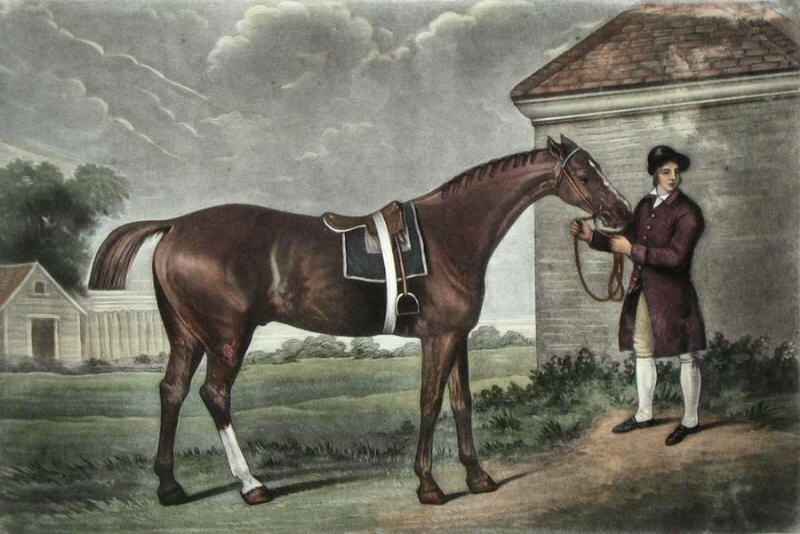
References
Bower, Dr. Mim et al " The cosmopolitan maternal heritage of the Thoroughbred racehorse breed shows a significant contribution from British and Irish native mares." 2010
www.bloodlines.net/highflyer.htm "Investigation into Eclipse", "Investigation into St. Simon" "English Half-Crown Horse"
Green, Dr. Ben K. Horse Conformation as to Soundness and Performance 1969
Hill, Dr. Emmeline et al "The genetic origin and history of speed in the Thoroughbred racehorse." 2012
Holmes, Laura "Racehorse Reality Check: Do Numbers Matter? 2018
Kirsan, Kathleen Legacy of Lexington 2015, Standardbred Sport Horses 2018, www.sport-horse-breeder.com: "Understanding Pedigrees", "Tesio Methods", "Origin of Sport Ability", "Irish Hobby"
MacKay-Smith, Alexander Speed and the Thoroughbred--the complete history 2000
Polaski, Dr. Daniel et al "Detection and Analysis of Polymorphism in the Promate Region of Equine PPARGCIA gene" 2018
Wallner, Dr. Barbara "Y Chromosome Uncovers the Recent Oriental Origin of Modern Stallions" June 2017 (Current Biology)
This is part II of a three part study. The introduction is here, part I: the Standardbred and Soundness is here. Part III- the Durable Quarter Horse plus the entire study conclusions here.
American Running Horse - series documenting the colonial development